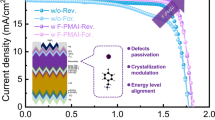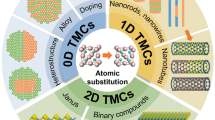Abstract
Interlayer excitons (IXs) formed in transition metal dichalcogenides (TMDs)/two-dimensional (2D) perovskite heterostructures are emerging as new platforms in the research of excitons. Compared with IXs in TMD van der Waals heterostructures, IXs can be robustly formed in TMDs/2D perovskite heterostructures regardless of the twist angle and thermal annealing process. Efficient control of interlayer coupling is essential for realizing their functionalities and enhancing their performances. Nevertheless, the study on the control of interlayer coupling strength between TMD and 2D perovskites is elusive. Therefore, we realize the control of interlayer coupling between monolayer WSe2 and (iso-BA)2PbI4 with SiO2 pillars in situ. An abnormal 10-nm blue shift and 2.5 times photoluminescence intensity enhancement were observed for heterostructures on the pillar, which was contrary to the red shift observed in TMD heterobilayers. We attributed the abnormal blue shift to the enhanced interlayer coupling arising from the reduced gap between constituent layers. In addition, IXs became more dominant over intralayer excitons with enhanced coupling. The interlayer coupling could be further engineered by tuning the height (h) and diameter (d) of pillars. In particular, an additional triplet IX showed up for the pillar with an h/d ratio of 0.6 due to the symmetry breaking of monolayer WSe2. The symmetry breaking also induced an anisotropic response of IXs. Our study is beneficial for tuning and enhancing the performance of IX-based devices, exciton localization and quantum emitters.
摘要
与过渡金属硫化物中的层间激子相比, 过渡金属硫化物与二维 钙钛矿间的层间激子有更高的鲁棒性, 且其光学性质与层间旋转角和 是否退火无关. 因此, 过渡金属硫化物与二维钙钛矿间的层间激子正成 为一个新的研究激子的体系. 层间激子的有效控制是实现其功能和提 高其性能的关键, 然而, 目前缺少对过渡金属硫化物与二位钙钛矿间层 间激子有效控制的研究. 本文利用二氧化硅纳米柱实现了单层WSe2和 (iso-BA)2PbI4二维钙钛矿间层间激子的定点调控. 与过渡金属硫化物 层间激子在应力作用下红移的现象相反, 我们在过渡金属硫化物和二 维钙钛矿间的层间激子中观测到10 nm的蓝移以及2.5倍的信号增强. 我们推断该蓝移是由层间间距减小导致的层间耦合强度增大引起的. 该推断也由观测到的层间激子相对自由激子的比例随着耦合强度的增 大而增大的现象验证. 同时, 层间耦合还可以通过改变纳米柱的直径和 高度进行调控. 特别地, 由于对称性被破坏, 我们在直径/高度比为0.6的 纳米柱上观测到三线态层间激子, 且层间激子的各项异性证明其对称 性确实已被破坏. 总之, 本研究对调控基于层间激子的光电器件、激子 局域态和量子光源具有一定促进作用.
Similar content being viewed by others

References
Rivera P, Schaibley JR, Jones AM, et al. Observation of long-lived interlayer excitons in monolayer MoSe2-WSe2 heterostructures. Nat Commun, 2015, 6: 6242
Jiang Y, Chen S, Zheng W, et al. Interlayer exciton formation, relaxation, and transport in TMD van der Waals heterostructures. Light Sci Appl, 2021, 10: 72
Fang H, Battaglia C, Carraro C, et al. Strong interlayer coupling in van der Waals heterostructures built from single-layer chalcogenides. Proc Natl Acad Sci USA, 2014, 111: 6198–6202
Xu W, Liu W, Schmidt JF, et al. Correlated fluorescence blinking in two-dimensional semiconductor heterostructures. Nature, 2017, 541: 62–67
Liu Y, Fang H, Rasmita A, et al. Room temperature nanocavity laser with interlayer excitons in 2D heterostructures. Sci Adv, 2019, 5: eaav4506
Miller B, Steinhoff A, Pano B, et al. Long-lived direct and indirect interlayer excitons in van der Waals heterostructures. Nano Lett, 2017, 17: 5229–5237
Liu Y, Dini K, Tan Q, et al. Electrically controllable router of interlayer excitons. Sci Adv, 2020, 6: eaba1830
Jauregui LA, Joe AY, Pistunova K, et al. Electrical control of interlayer exciton dynamics in atomically thin heterostructures. Science, 2019, 366: 870–875
Unuchek D, Ciarrocchi A, Avsar A, et al. Room-temperature electrical control of exciton flux in a van der Waals heterostructure. Nature, 2018, 560: 340–344
Rivera P, Seyler KL, Yu H, et al. Valley-polarized exciton dynamics in a 2D semiconductor heterostructure. Science, 2016, 351: 688–691
Rivera P, Yu H, Seyler KL, et al. Interlayer valley excitons in heterobilayers of transition metal dichalcogenides. Nat Nanotech, 2018, 13: 1004–1015
Sigl L, Sigger F, Kronowetter F, et al. Signatures of a degenerate many-body state of interlayer excitons in a van der Waals heterostack. Phys Rev Res, 2020, 2: 042044
Wang Z, Rhodes DA, Watanabe K, et al. Evidence of high-temperature exciton condensation in two-dimensional atomic double layers. Nature, 2019, 574: 76–80
Choi J, Florian M, Steinhoff A, et al. Twist angle-dependent interlayer exciton lifetimes in van der Waals heterostructures. Phys Rev Lett, 2021, 126: 047401
Yuan L, Zheng B, Kunstmann J, et al. Twist-angle-dependent interlayer exciton diffusion in WS2-WSe2 heterobilayers. Nat Mater, 2020, 19: 617–623
Lukman S, Ding L, Xu L, et al. High oscillator strength interlayer excitons in two-dimensional heterostructures for mid-infrared photo-detection. Nat Nanotechnol, 2020, 15: 675–682
Mukherjee A, Shayan K, Li L, et al. Observation of site-controlled localized charged excitons in CrI3/WSe2 heterostructures. Nat Commun, 2020, 11: 5502
Joshi J, Zhou T, Krylyuk S, et al. Localized excitons in NbSe2-MoSe2 heterostructures. ACS Nano, 2020, 14: 8528–8538
Xiao J, Zhang L, Zhou H, et al. Type-II interface band alignment in the vdW PbI2-MoSe2 heterostructure. ACS Appl Mater Interfaces, 2020, 12: 32099–32105
Chen Y, Liu Z, Li J, et al. Robust interlayer coupling in two-dimensional perovskite/monolayer transition metal dichalcogenide hetero-structures. ACS Nano, 2020, 14: 10258–10264
Liu W, Xing J, Zhao J, et al. Giant two-photon absorption and its saturation in 2D organic-inorganic perovskite. Adv Opt Mater, 2017, 5: 1601045
Wang J, Su R, Xing J, et al. Room temperature coherently coupled exciton-polaritons in two-dimensional organic-inorganic perovskite. ACS Nano, 2018, 12: 8382–8389
Blancon JC, Tsai H, Nie W, et al. Extremely efficient internal exciton dissociation through edge states in layered 2D perovskites. Science, 2017, 355: 1288–1292
Li J, Wang J, Ma J, et al. Self-trapped state enabled filterless narrowband photodetections in 2D layered perovskite single crystals. Nat Commun, 2019, 10: 806
Stoumpos CC, Cao DH, Clark DJ, et al. Ruddlesden-Popper hybrid lead iodide perovskite 2D homologous semiconductors. Chem Mater, 2016, 28: 2852–2867
Tsai H, Nie W, Blancon JC, et al. High-efficiency two-dimensional Ruddlesden-Popper perovskite solar cells. Nature, 2016, 536: 312–316
Tongay S, Fan W, Kang J, et al. Tuning interlayer coupling in large-area heterostructures with CVD-grown MoS2 and WS2 monolayers. Nano Lett, 2014, 14: 3185–3190
Ke L, van Schilfgaarde M. Band-filling effect on magnetic anisotropy using a Green’s function method. Phys Rev B, 2015, 92: 241408
Xia J, Yan J, Wang Z, et al. Strong coupling and pressure engineering in WSe2-MoSe2 heterobilayers. Nat Phys, 2021, 17: 92–98
He Y, Yang Y, Zhang Z, et al. Strain-induced electronic structure changes in stacked van der Waals heterostructures. Nano Lett, 2016, 16: 3314–3320
Cho C, Wong J, Taqieddin A, et al. Highly strain-tunable interlayer excitons in MoS2/WSe2 heterobilayers. Nano Lett, 2021, 21: 3956–3964
Wang W, Ma X. Strain-induced trapping of indirect excitons in MoSe2/WSe2 heterostructures. ACS Photonics, 2020, 7: 2460–2467
Castellanos-Gomez A, Roldán R, Cappelluti E, et al. Local strain engineering in atomically thin MoS2. Nano Lett, 2013, 13: 5361–5366
Li W, Lu X, Dubey S, et al. Dipolar interactions between localized interlayer excitons in van der Waals heterostructures. Nat Mater, 2020, 19: 624–629
Wang F, Wang J, Guo S, et al. Tuning coupling behavior of stacked heterostructures based on MoS2, WS2, and WSe2. Sci Rep, 2017, 7: 44712
Alexeev EM, Mullin N, Ares P, et al. Emergence of highly linearly polarized interlayer exciton emission in MoSe2/WSe2 heterobilayers with transfer-induced layer corrugation. ACS Nano, 2020, 14: 11110–11119
Tripathi LN, Iff O, Betzold S, et al. Spontaneous emission enhancement in strain-induced WSe2 monolayer-based quantum light sources on metallic surfaces. ACS Photonics, 2018, 5: 1919–1926
Qiu DY, Cao T, Louie SG. Nonanalyticity, valley quantum phases, and lightlike exciton dispersion in monolayer transition metal dichalcogenides: Theory and first-principles calculations. Phys Rev Lett, 2015, 115: 176801
Hanbicki AT, Chuang HJ, Rosenberger MR, et al. Double indirect interlayer exciton in a MoSe2/WSe2 van der Waals heterostructure. ACS Nano, 2018, 12: 4719–4726
Zhang L, Gogna R, Burg GW, et al. Highly valley-polarized singlet and triplet interlayer excitons in van der Waals heterostructure. Phys Rev B, 2019, 100: 041402
Yu H, Liu GB, Yao W. Brightened spin-triplet interlayer excitons and optical selection rules in van der Waals heterobilayers. 2D Mater, 2018, 5: 035021
Baranowski M, Surrente A, Klopotowski L, et al. Probing the interlayer exciton physics in a MoS2/MoSe2/MoS2 van der Waals heterostructure. Nano Lett, 2017, 17: 6360–6365
Kormányos A, Zólyomi V, Drummond ND, et al. Spin-orbit coupling, quantum dots, and qubits in monolayer transition metal dichalcogenides. Phys Rev X, 2014, 4: 011034
Molas MR, Faugeras C, Slobodeniuk AO, et al. Brightening of dark excitons in monolayers of semiconducting transition metal dichalcogenides. 2D Mater, 2017, 4: 021003
Yuan L, Wang T, Zhu T, et al. Exciton dynamics, transport, and annihilation in atomically thin two-dimensional semiconductors. J Phys Chem Lett, 2017, 8: 3371–3379
Zhang J, Zhu X, Wang M, et al. Establishing charge-transfer excitons in 2D perovskite heterostructures. Nat Commun, 2020, 11: 2618
Acknowledgements
This work was supported by the National Key Research and Development Program of China (2018YFA0704403), the National Natural Science Foundation of China (62005091 and 62074064), Hubei Provincial Natural Science Foundation (2020CFB194), and Huazhong University of Science and Technology (HUST) grant (2019kfyXJJS046).
Author information
Authors and Affiliations
Contributions
Wen X and Li D conceived the idea and supervised the project; Wei Q prepared the heterostructures and conducted the optical measurement; Hu J synthesized 2D perovskites; Chen Y, Liu Z, and Lin T helped in TMD transfer and EBL fabrication. All authors analyzed the data and commented on the manuscript.
Corresponding authors
Additional information
Conflict of interest
The authors declare that they have no conflict of interest.
Supplementary information
Supporting data are available in the online version of the paper.
Qinglin Wei received her BS degree from Huazhong University of Science and Technology (HUST) in 2019. She is currently pursuing her Master degree at the School of Optical and Electronic Information, HUST. Her research focuses on spectroscopy of transition metal dichalcogenides, two-dimensional perovskites and their heterostructures.
Xinglin Wen received his BS degree in physics from Wuhan University in 2011 and PhD degree from Nanyang Technological University in 2016. He was a post-doctor at Nanyang Technological University from 2016 to 2018. He is currently an associate professor at the School of Optical and Electronic Information, HUST. His research interests include two-dimensional materials, plasmonics and plasmon-exciton coupled system.
Dehui Li received his BS degree in physics from Xi’an Jiaotong University in 2006 and his MS degree from the Institute of Modern Physics, Chinese Academy of Sciences in 2009. He obtained his PhD degree from Nanyang Technological University in 2013. He was a post-doctor at the University of California, Los Angeles from 2013 to 2016. Currently, he is a professor at the School of Optical and Electronic Information, HUST. His research focuses on the synthesis and optoelectronic properties of functional semiconducting nanomaterials and heterostructures.
Supplementary Information
Rights and permissions
About this article
Cite this article
Wei, Q., Wen, X., Hu, J. et al. Site-controlled interlayer coupling in WSe2/2D perovskite heterostructure. Sci. China Mater. 65, 1337–1344 (2022). https://doi.org/10.1007/s40843-021-1911-6
Received:
Accepted:
Published:
Issue Date:
DOI: https://doi.org/10.1007/s40843-021-1911-6



